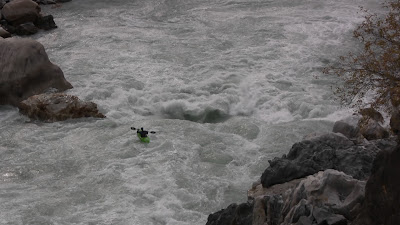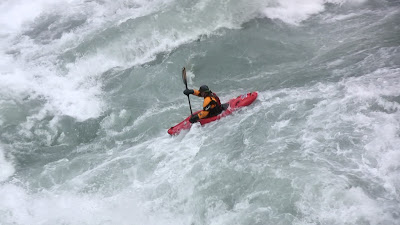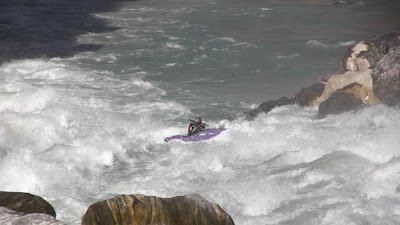 The Indus River is a Himalayan Giant whose headwaters juxtaposes the mighty Tsang Po/ Brahmaputra River in Central Tibet near the mystical peak of Kilash. Traveling 600 miles through Tibet, India, and Pakistan the Indus slams into the Karakoram Range of Northern Pakistan at 8000 feet above sea level. The following 100 miles of the Indus forms one of the most dramatic Gorges on the planet that at it's heart forms a chasm 2 miles deep and 12 miles wide.
The Indus River is a Himalayan Giant whose headwaters juxtaposes the mighty Tsang Po/ Brahmaputra River in Central Tibet near the mystical peak of Kilash. Traveling 600 miles through Tibet, India, and Pakistan the Indus slams into the Karakoram Range of Northern Pakistan at 8000 feet above sea level. The following 100 miles of the Indus forms one of the most dramatic Gorges on the planet that at it's heart forms a chasm 2 miles deep and 12 miles wide. Karakorum beauty: The Indus River bisects the two most prominent mountain ranges on earth. The Himalaya and the Karakorum. In addition to being the second highest mountain range in the world, the Karakorum is known for jagged spires that render some of it's more prominent peaks still unclimbed.
Karakorum beauty: The Indus River bisects the two most prominent mountain ranges on earth. The Himalaya and the Karakorum. In addition to being the second highest mountain range in the world, the Karakorum is known for jagged spires that render some of it's more prominent peaks still unclimbed. 30 day tourist visas to Pakistan are available for $120 usd, but are not valid for travel through restricted area. Please note that the entire country outside of Islamabad is a restricted area: make sure you have a guide!
30 day tourist visas to Pakistan are available for $120 usd, but are not valid for travel through restricted area. Please note that the entire country outside of Islamabad is a restricted area: make sure you have a guide!
Our "guide" and friend Roland Stevenson was our ticket to the Northern areas. Upon arriving in Islamabad, Roland quickly connected with old friends and new ones to make our trip up the Indus a snap. Roland is rapidly becoming the preeminent expedition coordinator in on the Indian sub-continent. Over the past three year's, he has spearheaded dozens of commercial and non-commercial trips through his cooperative whitewater company River India. I say cooperative because Roland uses his language and people skills to connect with the locals and give every trip a local partner.

Right to left (top to bottom) the whole crew including our intrepid Pakistani drivers: Chris Korbulic, Phil Boyer, Ben Stookesberry, Darin McQuoid, Roland Stevenson, Rashid and Mustafa.
 When 10 to 15 thousand cfs constricts to 50 or 60 feet and drops 20 - 30 the ride down the tounge is nearly out of control. Here on day 1, Rafa enters our first encounter with the full power of the Indus on day one. In this same rapid the surging hole/ wave that you can see in the middle closed out on me and I spent the second have of this rapid getting held upside down in the proverbial glacial strangle hold of the Indus. This was my wake up call: take off your pogies and get your gameface on because there is no one that can help you if something goes wrong out here.
When 10 to 15 thousand cfs constricts to 50 or 60 feet and drops 20 - 30 the ride down the tounge is nearly out of control. Here on day 1, Rafa enters our first encounter with the full power of the Indus on day one. In this same rapid the surging hole/ wave that you can see in the middle closed out on me and I spent the second have of this rapid getting held upside down in the proverbial glacial strangle hold of the Indus. This was my wake up call: take off your pogies and get your gameface on because there is no one that can help you if something goes wrong out here.

Day 1 part 2 "Himalayan Drainpipe"



The near the end of Day 2 and beautiful sandy beach that was bathed in light under a full moon that night.
Day 3 turned out to be the natural evolution of Day 2's dabble with boat scouting. The river had opened up into a long series of powerful read in run that might be more dangerous than a daunting scouts. In this type of water, a fellow paddler only 20 feet in front of you can be out of site do to double and tripple over-head crest to trough wave heights. Darin McQuoid accelerates into depths of the Indus gaining only breif cresting views of what lay in wait down stream.
Day 4 began with another lengthy section of big water read and run. But was soon punctuated by the Legendary falls at Asstack. Somehow photos just don't do this drop justice. Partly because you are not seeing the 10 foot surges in the pool and partly due to the conceptual problem of rationalizing 15,000 cfs through a slot like this. Also know that Rafa was the only one to enter the river this close to the falls as the froth you see him in something more like a storm cloud and less life a turbulent river.
Unfortunately for the group, Day 4 was Rafa's final day with us on the water as his two week sabbatical from his mechanical engendering studies could go no longer. Rafa's final drop dubed "Rafa's Last Stand" forebode what would soon become the norm on the Indus downstream. The river constricted to 15 feet wide between a diagonal pourover and a 200 foot pilar of bedrock. Again the river had acheived insane velocities generating massive boils in the pool below. In this photo Chris K is caught in the interface of the boils and the savage current.
Phil enters Rafa's last stand on Day 4 marking the end of Rafa's aggressive run on the first part of the Rondu and the beginning of the Bedrock Gorges to come.
The end of day 4 saw the rest of the group pushing on toward the next available beach for camp and met with more powerful drops on the Indus. Phil took my hand signals from his boat and ended up with an impressive surf in a huge hole. Phil definitely takes the freestyle prize for his clean air blunt.
Day 5 began with a call on the Radio from Roland up on the road. "You guys better take out at the swinging bridge around the corner. There is a massive rapid there that leads to a 5 mile long vertical walled gorge. Some of the rapids in there look unportagable and/ or unscoutable from river level."
3 hours later I joined whitewater veteran 40 year old Phil Boyer for an attempt on the Day 5 Gorge. In this photo Phil fights for his ferry as the madatory but scoutable entrance slide to the Canyon smashes into the left wall at the bottom.
The next rapid in the swinging bridge gorge of day 5 was only marginally scoutable from 200 feet off the deck. Phil enters with a perfect sub-out clearing the huge hole on the right and the recirculating wall on the left. Phil and I racked up our collective 4th and 5th portages of the trip on the last two major drops ending with a 30 foot seal launch back into the Indus.
Even the flat water on the Indus is deceptively strong. Floating towards the first rapid of day 6, Chris Korbulic has little time to relax as the steady 10 mile an hour current speeds him toward more towering whitewater.
Chris Korbulic entering day 6 in the Rondu Gorge of the Indus.
Big water to tight moves and visaversa is a halmark of the Indus and exemplified on day 6. Darin mcQuoid inbetween big ones.
Phil Boyer lines up for the entrance slide to a huge rapid called slide left on Day 6.
Day 6 Darin Mcquoid Half-way through his probe run on "Slide Left" establishing the center line.
Chris Korbulic Thankfull that this is only part of the flow of the Indus on Day 6.
Darin McQuoid takes a rare opportunity to skirt the main flow through a steep section of boulders after the Previous Big ledge on day 6.
Chris Korbulic going for a surf at the end of day 6.
Darin McQuoid launches into a big one at the beginning of day 7 our way into one of the most daunting gorges on the run.
The largest single feature on the Indus showed up early on day 7 where all 15,000 cfs literally atomizes into a 40 foot drop.
Where's Chris Korbulic? Find Chris exiting the falls on day 7 to put perspective into this photo.
Phil Boyer leads the juicy side of a river wide series of ledges and seething toungs. Well into a committing gorge on day 7, this seemingly solid toung of whitewater swallowed phil halway down the drop.
Early on Day 8 we encountered another Cathedral sized rapid that mocked into a pothole filled wall. The rapid was too risky for 9 am in the middle of the Rondu and became our 10th collective portage of the trip.
This visual of Phil is one of the best from the Indus midway through Day 8. This is just the final move of a 1 km long rapid that took us almost an hour to scout from top to bottom. Once in the rapid foaming 8 foot haystacks and the occasional ledge hole was framed by a patch work of sieving hotel sized boulders... In other worlds, once you were in the maelstrom the only way out was down the middle through a massive,backed up, but flushing hole.
Darin McQuoid in the Same rapid on Day 8 dubbed "The Road to Perdition".
We called it early on day 8 in anticipation of another committed canyon that would make up Day 9 leading to the beautiful Haramosh Valley. Staying the night at an in just downstream we were able to anticipate and scout this rapid from the road. Again this rapid is like something out of the North Payette, but on another 10,000 cfs of steroids. 1 km long, massive ledge holes and a couple of very fine lines down the left side. In this photo Phil finds the flushing side of a massive river wide hole.
Darin finds himself with nowhere to run in the Middle of the same rapid on Day 9. He was forced to take the mandatory surf diagonally towards a flushing windown on the right. After running this monstor successfully the whole group felt a boost of confidence as we entered the final 20 kms under a cool fall blue sky.


Inspired by Haramosh's wonderful People and high mountain Asthetic, I take the "Leap of Faith" on the Indus after school on Day 10 into one of it's more impressive Hydraulic features. For me this rapid exemplified the graduer and the power of the Indus in addition to visually runnable lines. Shukriah al humdila!
Another look at this truly spectacular falls on the Indus on Day 10.
 Chris Korbulic enters another massive riverwide hole on the Lower Indus on Day 10. At this point we were really in tune with the river and were running many rapids that we might have portaged at the beginning of the trip. Everyone would come away from the Indus feeling like there whitewater perspective had certainly been broadened.
Chris Korbulic enters another massive riverwide hole on the Lower Indus on Day 10. At this point we were really in tune with the river and were running many rapids that we might have portaged at the beginning of the trip. Everyone would come away from the Indus feeling like there whitewater perspective had certainly been broadened. With just one more portage at the beginning of Day 11 we would finish the Rondu with just 11 collective portages establishing the most complete river whitewater descent of the Rondu to date. It seemed everyday would bring a little more winter with it, and our final night on the river we woke up to heavy snowfall clinging to the surrounding mountains. I think the Rondu Gorge is so deep that precipitation can easilly disipate from peaks that are 10 to 18 thousand feet overhead.
With just one more portage at the beginning of Day 11 we would finish the Rondu with just 11 collective portages establishing the most complete river whitewater descent of the Rondu to date. It seemed everyday would bring a little more winter with it, and our final night on the river we woke up to heavy snowfall clinging to the surrounding mountains. I think the Rondu Gorge is so deep that precipitation can easilly disipate from peaks that are 10 to 18 thousand feet overhead. On Day 11 the Indus did not let up until literally 2 km above our take out leaving us with 12 kms of big water still to negociate to the confluence with the Gilgit River. In one of the Rapids, I took my heavyest pounding of the trip in a monster hole that I felt extremely lucky to escape from. Even this close to our would be take out, any sort of swim is potentially life threatening.
On Day 11 the Indus did not let up until literally 2 km above our take out leaving us with 12 kms of big water still to negociate to the confluence with the Gilgit River. In one of the Rapids, I took my heavyest pounding of the trip in a monster hole that I felt extremely lucky to escape from. Even this close to our would be take out, any sort of swim is potentially life threatening.
In the Final few Kms of the Rondu and Day 11 the classic boat scout insued as we held rank through monster whitewater.
 With our final scout and one last duck dive into the gulf of yet another Massive on our final and 11th Day in the Rondu, a feeling of elation and accomplishment swept over me like I have felt few other times in my kayaking career. Once again I am literally gafaaed at the power of mother nature and the beauty of the Other side of the world. Our Glimpse of the Rondu area of the Indus was a snap shot in time that can never be repeated. From the massive flows and fluctuations there in that ravage the Rondu year after year I can only imgin how different every flow and therefore time of year must be. I can only think that our confluence of good weather, perfect water levels, great group dynamics, and superb interactions with the local peoples where Serendipitus. But then again, looking back at many stories from this awe inspiring region so many our of the extremely positive variety at least if not life altering. I would encourage anyone to make the trip for any number of cultural or adventure tourist itenararies!
With our final scout and one last duck dive into the gulf of yet another Massive on our final and 11th Day in the Rondu, a feeling of elation and accomplishment swept over me like I have felt few other times in my kayaking career. Once again I am literally gafaaed at the power of mother nature and the beauty of the Other side of the world. Our Glimpse of the Rondu area of the Indus was a snap shot in time that can never be repeated. From the massive flows and fluctuations there in that ravage the Rondu year after year I can only imgin how different every flow and therefore time of year must be. I can only think that our confluence of good weather, perfect water levels, great group dynamics, and superb interactions with the local peoples where Serendipitus. But then again, looking back at many stories from this awe inspiring region so many our of the extremely positive variety at least if not life altering. I would encourage anyone to make the trip for any number of cultural or adventure tourist itenararies!
(Front to Back) Darin McQuoid, Phil Boyer, and Chris Korbulic let the accomplishment wash over them as they float beyond the Eye of the Lion on day 11.

The long way home.

































2 comments:
where you drinking nuun in pakistan?
Ben,
Props for ignoring our fear-mongering govt and media by going to a place most people would never consider.
From what you told me about the Indus and what I see here I know this is river I'll have to run someday.
-BH
Post a Comment